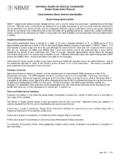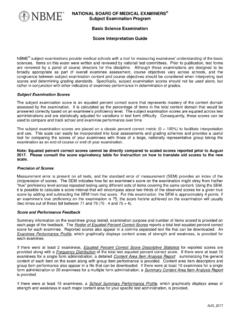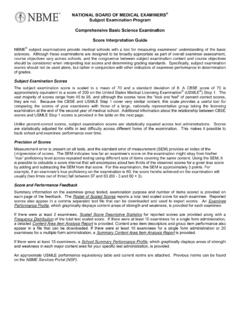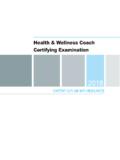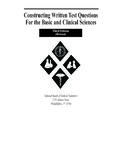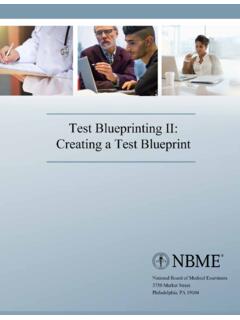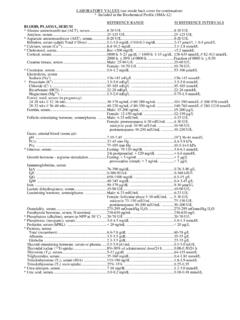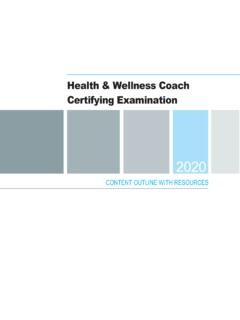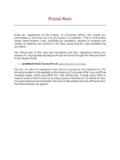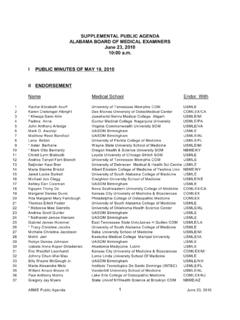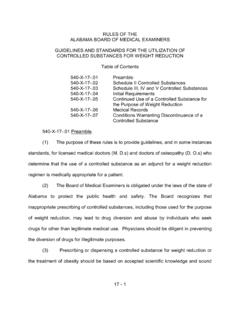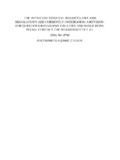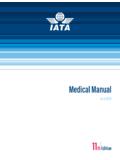Transcription of NATIONAL BOARD OF MEDICAL EXAMINERS Subject …
1 NATIONAL BOARD OF MEDICAL EXAMINERS Subject Examination Program Clinical Science Examination score Interpretation Guide New score scale information ( effective august 2015 ) GRPID:CLNEURO$$ NBME Subject examinations provide MEDICAL schools with a tool for measuring examinees' understanding of the clinical sciences. Items on this examination were written and reviewed by NATIONAL test committees. Prior to publication, test forms are reviewed by a panel of course directors from this discipline. Although these examinations are designed to be broadly appropriate as part of overall examinee assessment, course objectives vary across schools, and the congruence between Subject examination content and course objectives should be considered when interpreting test scores and determining grading standards. Specifically, Subject examination scores should not be used alone, but rather in conjunction with other indicators of examinee performance in determination of grades.
2 Subject Examination Scores The Subject examination score is an equated percent correct score that represents mastery of the content domain assessed by the examination. It is calculated as the percentage of items in the total content domain that would be answered correctly based on an examinee s proficiency level. The Subject examination scores are equated across test administrations and are statistically adjusted for variations in test form difficulty. Consequently, these scores can be used to compare and track school and examinee performance over time. The Subject examination scores are placed on a classic percent correct metric (0 100%) to facilitate interpretation and use. This scale can easily be incorporated into local assessments and grading schemes and provides a useful tool for comparing the scores of your examinees with those of a large, nationally representative group taking the examination as an end- of-course or end-of-clerkship examination.
3 Note: Equated percent correct scores cannot be directly compared to scaled scores reported prior to august 2015 . Please consult the score equivalency table for instruction on how to translate old scores to the new scale . Precision of Scores Measurement error is present on all tests, and the standard error of measurement (SEM) provides an index of the (im)precision of scores. The SEM indicates how far an examinee s score on the examination might stray from his/her true proficiency level across repeated testing using different sets of items covering the same content. Using the SEM, it is possible to calculate a score interval that will encompass about two thirds of the observed scores for a given true score by adding and subtracting the SEM from that score . For this examination, the SEM is approximately 4 points. If an examinee s true proficiency on the examination is 75, the score he/she achieved on the examination will usually (two times out of three) fall between 71 and 79 ( 75 - 4 and 75 + 4).
4 score and Performance Feedback Summary information on the examinee group tested, examination purpose and number of items scored is provided on each page of the feedback. The Roster of Equated Percent Correct Scores reports a total test equated percent correct score for each examinee. Reported scores also appear in a comma separated text file that can be downloaded. An Examinee Performance Profile, which graphically displays content areas of strength and weakness, is provided for each examinee. If there were at least 2 examinees, Equated Percent Correct score Descriptive Statistics for reported scores are provided along with a Frequency Distribution of the total test equated percent correct score . If there were at least 10 examinees for a single form administration, a detailed Content Area Item Analysis Report summarizing the general content of each item on the exam along with group item performance is provided. Content area item descriptors and group item performance also appear in a file that can be downloaded.
5 If there were at least 10 examinees for a single form administration or 20 examinees for a multiple form administration, a Summary Content Area Item Analysis Report is provided. If examinees were tested at your school in the previous academic year, a Year-End Report is provided. The report summarizes the performance of first-time takers and is posted annually in November to the NBME Services Portal (NSP). NATIONAL BOARD OF MEDICAL EXAMINERS Subject Examination Program Clinical Science Examination score Interpretation Guide New score scale information ( effective august 2015 ) GRPID:CLNEURO$$ Grading Guidelines Grading guidelines for this exam have been developed by a nationally representative group of clerkship directors to assist schools and institutions in setting fair and valid passing and honors standards for students taking this exam. An abbreviated summary of the grading guidelines is provided and the full study with a list of participating schools is reported on NSP.
6 Norms Total academic year and quarterly norms are provided to aid in the interpretation of examinee performance. The norms reflect the performance of first-time taker examinees who took a paper and/or web form as an end-of-course or end-of-clerkship examination across an entire academic year and by quarterly testing periods. Quarterly norms have been provided because scores in some Subject examinations are progressively higher for examinees of equivalent ability who take the relevant clerkship later in the academic year. This information may have particular relevance to schools that use the norm tables in the development of grading guidelines. The two most recent sets of norms that have been developed for this examination are provided for your convenience and are reported on the equated percent correct score scale . Norms will be updated in November to reflect the most recent academic year of data. Norms can also be found on NSP. NATIONAL BOARD OF MEDICAL EXAMINERS Subject Examination Program Clinical Science Examination score Equivalency Table This table is intended to aid in your transition to the new Subject examination score scale .
7 The new Subject examination score is an equated percent correct score that represents mastery of the content domain assessed by the examination. It is calculated as the percentage of items in the content domain that would be answered correctly based on an examinee s proficiency level. The new Subject examination scores are placed on a classic percent correct metric (0 100%) to facilitate interpretation and use. The table below provides approximate performance equivalents from the old scaled score to the new equated percent correct score . To use the table, locate an examinee s score in the column labeled Old Scaled score and look across to the column labeled Equated Percent Correct Equivalent . This number indicates the examinee s equivalent equated percent correct score . This table is also available on the NBME Services Portal (NSP) as a file that can be downloaded. Approximate Subject Examination Scaled score to Equated Percent Correct score Equivalency Table Old Scaled score Equated Percent Correct Equivalent Old Scaled score Equated Percent Correct Equivalent Old Scaled score Equated Percent Correct Equivalent Old Scaled score Equated Percent Correct Equivalent 99 98 74 75 49 36 24 10 98 94 73 73 48 35 23 9 97 94 72 72 47 33 22 8 96 93 71 71 46 32 21 8 95 93 70 69 45 31 20 7 94 92 69 68 44 29 19 7 93 92 68 66 43 28 18 7 92 91 67 65 42 27 17 6 91 90 66 63 41 25 16 6 90 90 65 62 40 24 15 5 89 89 64 60 39 23 14 5 88 88 63 59 38 22 13 5 87 88 62 57 37 21 12 4 86 87 61 55 36 20 11 4 85 86 60 54 35 18 10 4 84 85 59 52 34 17 9 4 83 84 58 51 33 16 8 3 82 83 57 49 32 16 7 3 81 83 56 47 31 15 6 3 80 81 55 46 30 14 5 3 79 80 54 44 29 13 4 2 78 79 53 43 28 12 3 2 77 78 52 41 27 12 2 2 76 77 51 39 26 11 1 1 75 76 50 38 25 10 NATIONAL BOARD OF MEDICAL
8 EXAMINERS Subject Examination Program Clinical Science Examination Grading Guidelines (Reported on the Equated Percent Correct score scale ) In 2005, the NBME began conducting webcast standard setting studies for the Clinical Science Subject Examination with MEDICAL school faculty from across the United States. For each study, MEDICAL school faculty participated as expert judges in webcast sessions that utilized the internet and conference calling to train participants in the standard setting procedure. Judges reviewed the content and rated the difficulty of each item on a current form of the examination. Each study employed both a Modified Angoff content-based procedure and the Hofstee Compromise standard setting method. These two procedures together provide proposed passing standards that are based on an in-depth item-by-item analysis of the examination content, as well as, a more global analysis of the content. The results were summarized and the proposed standards were expressed as the proportion of the content required for a candidate to pass and to receive honors status.
9 Table 1 provides a summary of the MEDICAL school faculty who served as expert judges and their school information for each of the webcast studies conducted by the NBME. Table 1 Demographics of Expert Judges and Schools Participating in Webcast Studies Standard Setting Study Number of Judges Years of Experience % Clerkship Directors Number of Schools Traditional School Curriculum School Clerkship Length 2005 20 1 - 17 100% 20 43% 2 6 weeks 2010 14 1 23 79% 14 21% 2 6 weeks The data shown below represent a compilation of the opinions of the MEDICAL school faculty who participated in the webcast studies. The results reported have been converted from the old scaled score to the new Subject examination Equated Percent Correct score scale effective august 2015 . The study results are provided to assist you in setting fair and valid standards for this examination. Table 2 provides a summary of the results for passing scores from the Modified Angoff and Hofstee Compromise procedures.
10 The recommended minimum passing score based on the 2010 Angoff results is an equated percent correct score of 55 which is slightly higher than the recommended standard in 2005. This score fell well within the acceptable range of minimum passing scores (52 to 65) computed from the 2010 Hofstee results, which suggest that any standard selected within this range would be reasonable. The recommended minimum passing score based on the 2010 Hofstee results is a Subject exam score of 60, which is also higher than the 2005 Hofstee results. Table 2 Grading Guidelines for Passing (Mean Equated Percent Correct Scores) Standard Setting Study Number of Judges Modified Angoff Hofstee Compromise Recommended Passing score Range of Acceptable Minimum Passing Scores Recommended Passing score 2005 20 52 52 to 63 57 2010 14 55 52 to 65 60 Table 3 provides a summary of the Hofstee results for honors. The 2010 study results indicate that the minimum acceptable score for honors should fall between a score of 75 to 85.
